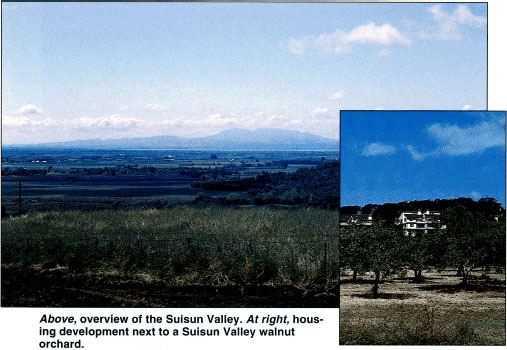All Issues
Views in the Suisun Valley: Rural dwellers divided on how to head off urbanization
Publication Information
California Agriculture 52(3):14-14. https://doi.org/10.3733/ca.v052n03p14
Published May 01, 1998
PDF | Citation | Permissions
Full text
Above, overview of the Suisun Valley. At right, housing development next to a Suisun Valley walnut orchard.
The Suisun Valley in Solano County is one of California's most visible illustrations of competing land uses at the rural-urban frontier. This 10,000-acre area of small farms, rural homes and wooded hills is a prime target for urban development, due to its attractive amenities and proximity to millions of metropolitan residents. Located alongside Interstate 80 and adjacent to the rapidly growing city of Fairfield, the Suisun Valley lies directly in the path of intense urban pressure.
How do local people view the prospects of urbanization of the valley? And what do they think should be done about it, if anything?
Such questions guided a series of focus-group interviews conducted in late 1995 with 65 local residents, most of them Suisun Valley landowners. The project was planned as an informational contribution to further citizen and local government deliberation about the future of the valley. It was organized and carried out by a research team from UC Cooperative Extension, in cooperation with Solano County government. Organizers of the project and authors of the report are Larry Clement, CE director in Solano County; AI Sokolow and Joan Wright, CE specialists on the Davis campus; and planning consultant Mary Handel.
Overwhelmingly, focus-group participants liked living and farming in the area and preferred to maintain its rural characteristics. Yet, mindful of the pressures of urbanization from the adjacent city of Fairfield and the nearby Bay Area, more than half saw substantial urbanization as inevitable.
While some referred to expected reductions in the quality of life, such as increased congestion on local roads, most discussion about the impacts of urbanization dealt with impacts on the economic viability of local farming.
As to what, if anything, to do to head off the expected changes, residents in this sample were sharply divided between those who favored aggressive policy actions and those who disliked governmental action for this purpose.
About one-third were generally inclined to “go with the flow,” expressing more passive views than others about future events and unsympathetic to planning and regulatory actions that restrict landowner options. Some participants in this category hoped to sell their property for development, although the dominant sentiment was more concerned with the inevitability of urbanization and oppositions to regulation.
The other two-thirds of the focus-group participants discussed two general approaches to protecting the valley's rural and agricultural characteristics: enhancing the profitability of local farming, and imposing additional land-use controls.
The participants suggested several ways of making local farming more profitable: direct marketing of farm produce, planting higher value crops, creating incentives to attract young people into local farming – such as technical assistance – and ensuring water supply at affordable prices.
Suggested land-use approaches included giving permanent status to Measure A (a Solano County policy that limits development outside cities), zoning for larger parcels (the current minimum is 40 acres), purchasing conservation easements on farmland, creating a preservationist coalition, limiting the extension of public services to the area, and establishing an urban growth strategy for Fairfield that limits annexation and produces higher municipal densities.
Copies of “Suisun Valley and the Future: Focus Group Views of Farming, Rural Character and Urban Growth” are available from the UC Cooperative Extension Office in Solano County (Fairfield), (707) 421-6790.





